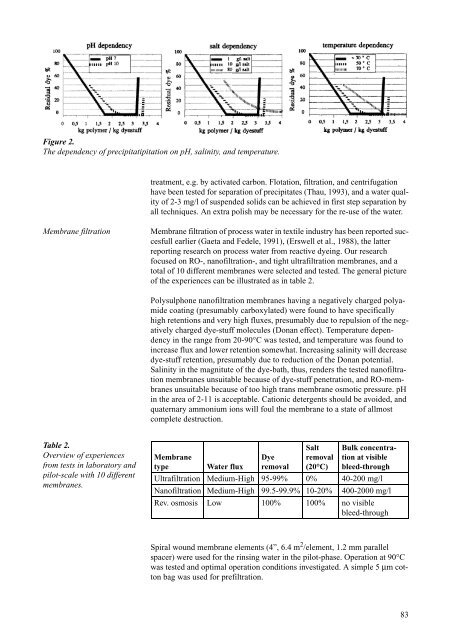Cleaner Technology Transfer to the Polish Textile ... - Miljøstyrelsen
Cleaner Technology Transfer to the Polish Textile ... - Miljøstyrelsen
Cleaner Technology Transfer to the Polish Textile ... - Miljøstyrelsen
Create successful ePaper yourself
Turn your PDF publications into a flip-book with our unique Google optimized e-Paper software.
Figure 2.<br />
The dependency of precipitatipitation on pH, salinity, and temperature.<br />
treatment, e.g. by activated carbon. Flotation, filtration, and centrifugation<br />
have been tested for separation of precipitates (Thau, 1993), and a water quality<br />
of 2-3 mg/l of suspended solids can be achieved in first step separation by<br />
all techniques. An extra polish may be necessary for <strong>the</strong> re-use of <strong>the</strong> water.<br />
Membrane filtration Membrane filtration of process water in textile industry has been reported succesfull<br />
earlier (Gaeta and Fedele, 1991), (Erswell et al., 1988), <strong>the</strong> latter<br />
reporting research on process water from reactive dyeing. Our research<br />
focused on RO-, nanofiltration-, and tight ultrafiltration membranes, and a<br />
<strong>to</strong>tal of 10 different membranes were selected and tested. The general picture<br />
of <strong>the</strong> experiences can be illustrated as in table 2.<br />
Table 2.<br />
Overview of experiences<br />
from tests in labora<strong>to</strong>ry and<br />
pilot-scale with 10 different<br />
membranes.<br />
Polysulphone nanofiltration membranes having a negatively charged polyamide<br />
coating (presumably carboxylated) were found <strong>to</strong> have specifically<br />
high retentions and very high fluxes, presumably due <strong>to</strong> repulsion of <strong>the</strong> negatively<br />
charged dye-stuff molecules (Donan effect). Temperature dependency<br />
in <strong>the</strong> range from 20-90°C was tested, and temperature was found <strong>to</strong><br />
increase flux and lower retention somewhat. Increasing salinity will decrease<br />
dye-stuff retention, presumably due <strong>to</strong> reduction of <strong>the</strong> Donan potential.<br />
Salinity in <strong>the</strong> magnitute of <strong>the</strong> dye-bath, thus, renders <strong>the</strong> tested nanofiltration<br />
membranes unsuitable because of dye-stuff penetration, and RO-membranes<br />
unsuitable because of <strong>to</strong>o high trans membrane osmotic pressure. pH<br />
in <strong>the</strong> area of 2-11 is acceptable. Cationic detergents should be avoided, and<br />
quaternary ammonium ions will foul <strong>the</strong> membrane <strong>to</strong> a state of allmost<br />
complete destruction.<br />
Membrane<br />
type Water flux<br />
Dye<br />
removal<br />
Salt<br />
removal<br />
(20°C)<br />
Bulk concentration<br />
at visible<br />
bleed-through<br />
Ultrafiltration Medium-High 95-99% 0% 40-200 mg/l<br />
Nanofiltration Medium-High 99.5-99.9% 10-20% 400-2000 mg/l<br />
Rev. osmosis Low 100% 100% no visible<br />
bleed-through<br />
Spiral wound membrane elements (4”, 6.4 m 2 /element, 1.2 mm parallel<br />
spacer) were used for <strong>the</strong> rinsing water in <strong>the</strong> pilot-phase. Operation at 90°C<br />
was tested and optimal operation conditions investigated. A simple 5 µm cot<strong>to</strong>n<br />
bag was used for prefiltration.<br />
83

















